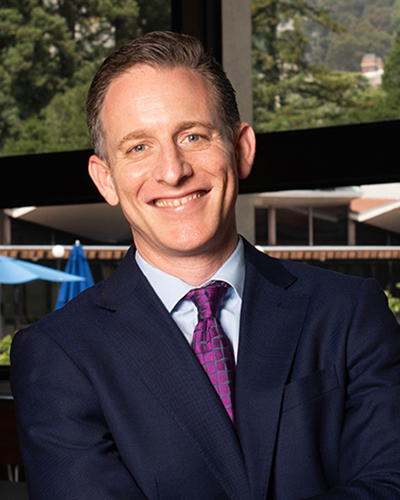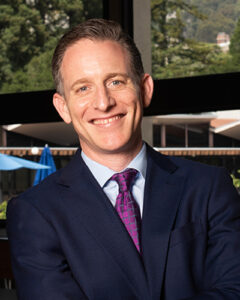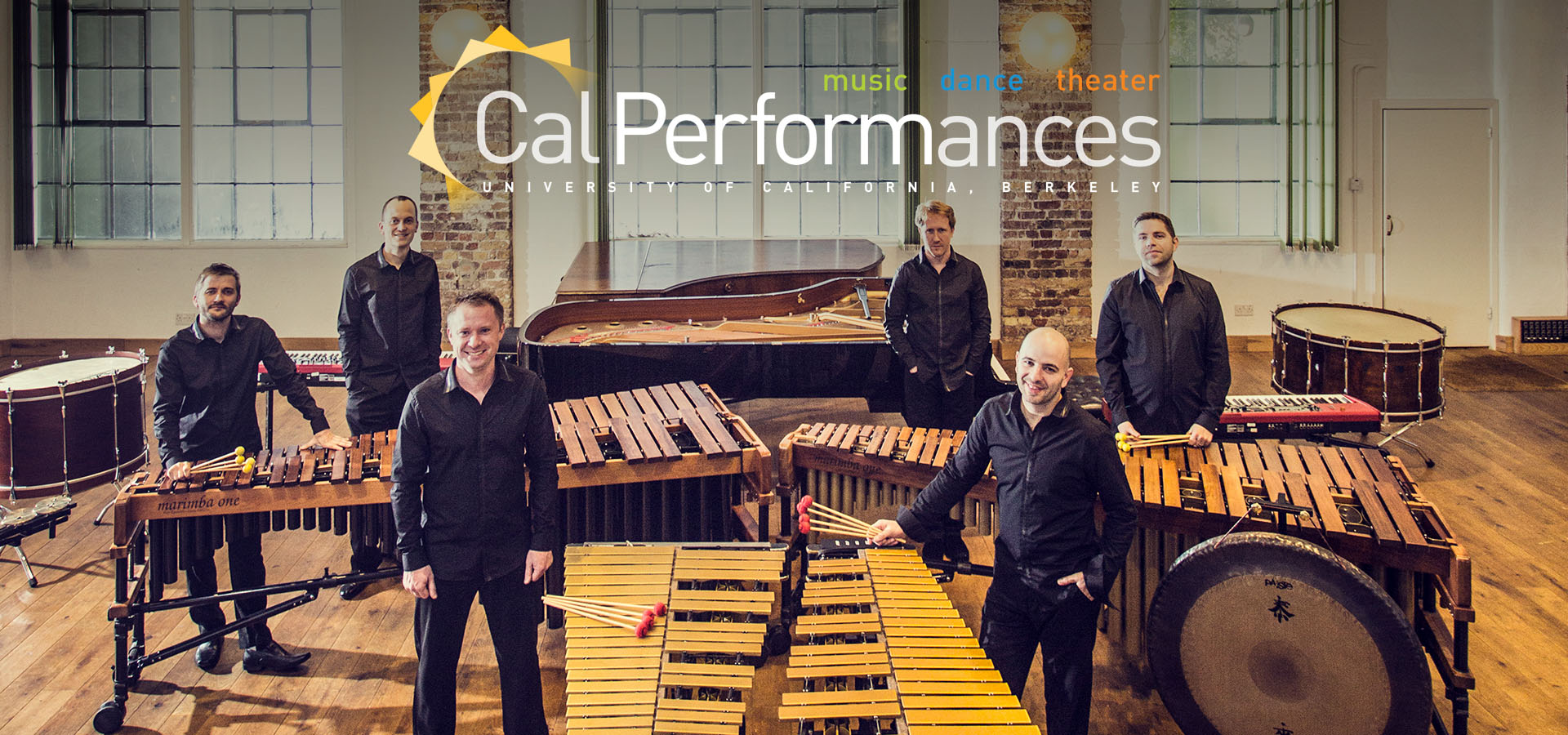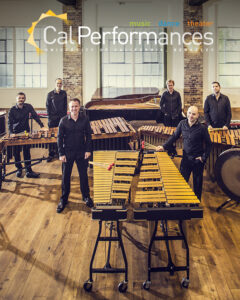Variations on Steve Reich:
A Celebration by the Colin Currie Group and Synergy Vocals
Steve Reich’s stature among the preeminent composers of our era has been so long established that it’s easy to forget how marginalized he was during the early years of his career (as was fellow Juilliard classmate Philip Glass). Take his landmark piece Four Organs (1970), which was first heard at the Guggenheim Museum in New York. When an emerging young conductor named Michael Tilson Thomas included it on a Boston Symphony program at Carnegie Hall in 1973, the antagonistic reaction from part of the audience turned the event into one of the most-talked-about scandals in contemporary music.
Reich’s innovations went on to have an impact far beyond the rarefied sphere of the avant-garde. The spectrum of his influence ranges from cutting-edge modern dance ensembles to DJs working the dance club floor. According to the British critic Andrew Clements, Reich belongs to the mere “handful of living composers who can legitimately claim to have altered the direction of musical history.”
“Western music before 1750 and from Debussy onwards, as well as jazz and non-Western music, are the sources from which I’ve drawn almost everything,” Reich once remarked. Among those non-Western sources are Ghanaian drumming, Balinese gamelan, and the Sephardic music in which Reich began immersing himself in the mid-1970s in Israel.
Ever since its founding in 2006 to present a performance of Reich’s early large-scale composition, Drumming (1970-71), the Colin Currie Group has specialized in his music, often collaborating with the composer directly to prepare their interpretations. Joined by Synergy Vocals, their Cal Performances program celebrates various parts of Reich’s long-spanning career. The earliest, Music for 18 Musicians (1974-76), consolidated his signature process of phasing, which Reich had elaborated over the previous decade, with more sensuous sonorities and a mesmerizing undertow of harmonic movement.
With his settings of psalm verses in Tehillim (1980-81), Reich reintroduced text into his music for the first time since the breakthrough tape pieces of the mid-1960s (It’s Gonna Rain and Come Out). He also belatedly began addressing the topic of his own Jewish heritage—a thread that would continue in such significant works as Different Trains (1988), which reflects on the Holocaust; the opera The Cave (1993); You Are (Variations) (2004); Daniel Variations (2006), a memorial to the murdered journalist Daniel Pearl; and WTC 9/11 (2010), Reich’s response to the terrorist attacks on the World Trade Center. (The Kronos Quartet’s acclaimed recording of Different Trains won the 1990 Grammy Award for Best Contemporary Classical composition.)
Traveler’s Prayer (2020)—a Cal Performances co-commission that receives its West Coast premiere this evening—is the most recent composition on the program. It picks up the thread begun with Tehillim but explores some new directions that may take longtime followers of the composer by surprise. Now in his mid-80s (he turned 86 just last month), Reich continues to develop his art, enriching his profoundly influential legacy.
Tehillim
On September 20, 1982, Time magazine published “The Heart Is Back in the Game” by its classical music critic Michael Walsh (back when mainstream publications still made a pretense of covering the beat). The article firmly attached the catch-all label of Minimalism to the triumvirate of Philip Glass, Steve Reich, and John Adams—so firmly that it continues to stick, even as each composer went on to take a distinctively separate path.
Walsh made a point to single out Tehillim as an exuberant exemplar of the style, praising it as “an infectious, high-spirited laudation,” adding that “Minimalism, a joyous, exciting—and sometimes maddening—amalgam of influences as disparate as African drumming, the Balinese gamelan, and new-wave rock, has come uptown at last.” He was referring to the orchestral premiere scheduled that week with the New York Philharmonic under Zubin Mehta. (Reich and his ensemble had given Tehillim’s world premiere at West German Radio in Cologne, led by George Manahan, in 1981, and soon after gave the first US performance at the Rothko Chapel in Houston.)
But with Tehillim, Reich was proceeding to chart new territory markedly different from the “Minimalist” austerity and frugality of the earlier 1960s tape pieces in which he had pioneered his phasing process by setting repetitive loops in a constantly shifting counterpoint. Having turned his attention to working with live instruments in the late 1960s and ’70s, Reich added text-setting to his palette in Tehillim. His score calls for four female voices (high soprano, two lyric sopranos, and alto) along with a chamber ensemble of woodwinds, six percussionists (playing small tuned tambourines with no jingles, clapping, maracas, marimba, vibraphone, and crotales), two electric organs, and strings; the voices, winds, and strings are amplified.
Tehillim literally means “praises” in Hebrew and is the word used for the biblical psalms attributed to David. Reich’s fascination with non-Western musical traditions had previously led him to study drumming at the Institute for African Studies at the University of Ghana in Accra and, later, to explore Balinese gamelan ensembles. All of this triggered an epiphany about how traditions get passed down over generations. “Don’t I have anything like that?” the composer recalls asking himself, and then realizing: “Wait a minute, I’m a member of one of the oldest surviving groups on the planet. And I don’t know anything about it!” So he set about learning more about Jewish tradition and began studying Hebrew.
Reich points out that the word Tehillim (pronounced “teh-hill-leem”) derives from the same three-letter Hebrew root as “Halleluyah”: hll (hey, lamed, lamed)—and, indeed, the impulse to praise gives this score an uplifting quality. Tehillim is divided into four parts based, respectively, on Psalms 19, 34, 18, and 150 (the Hebrew sources are listed first, followed in parentheses by the corresponding translations in the Christian bible): 19:2-5 (19:1-4), 34:13-15 (34:12-14), 18:26-27 (18:25-26), and 150:4-6.
Reich explains that one reason he chose to set excerpts from Psalms (as opposed to other parts of Jewish scripture) is that he felt liberated to compose his own melodies, using the flexible rhythms of the texts to suggest musical rhythms: the oral tradition for these texts, which were obviously meant to be sung, did not survive in the West (though, he adds, this tradition has been maintained by the Yemenite Jewish community, where the music is “microtonal and not on our tempered scales”). Part of the large percussion section is meant to suggest the closest modern analogies to the kinds of instruments that would have been used in biblical times: hand-clapping, rattles, tuned tambourines (without jingles), and small pitched cymbals. “Beyond this, there is no musicological content to Tehillim,” Reich says. “No Jewish themes were used for any of the melodic materials.”
The first part (Psalm 19) develops a sequence of canons building up to four-part canons (for all of the voices) on each of the four verses. A transition on the drum leads to the contrastingly homophonic second part (Psalm 34), featuring two- and three-voice harmony, with English horn, clarinet, drums, and clapping interwoven into the texture. The attention to melody here was inspired by Reich’s encounters with Sephardic cantillation. Overall, he writes, “the effect is of a melodic line growing longer and more ornate.”
The third part (Psalm 18) is a slow movement and grows more chromatic, beginning as a duet between two voices; the marimba and vibraphone define the percussion texture. Ending with his extracts from Psalm 150 in part four, Reich recapitulates techniques from the first three parts and returns to the opening tempo. The full ensemble joins together for the coda, which sets the word Halleluyah in an affirmative D major.
Traveler’s Prayer
Traveler’s Prayer is Steve Reich’s “pandemic piece,” though he began composing it before the spread of coronavirus in 2020 shut the world down. That seismic event thus “shifted the gravity of the words I was setting,” according to the composer, who completed the score while locked down in California. The Colin Currie Group and Synergy Vocals gave the world premiere in October 2021 at the Amsterdam Concertgebouw in a program marking the composer’s 85th birthday; earlier this week, they presented the first US performance at Carnegie Hall.
Like Tehillim, Traveler’s Prayer calls for a quartet of vocalists—in this case, two sopranos and two tenors. The ensemble consists of 11 players: tuned percussion (two vibraphones), piano, and strings (four violins and pairs of violas and cellos). And as with Tehillim, Reich chose texts from Hebrew Scriptures, including short excerpts not only from Psalms but from Genesis and Exodus as well. These texts are usually added to the complete Tefilat Haderech (known in English as the Wayfarer’s Prayer or the Traveler’s Prayer) that is found in Hebrew prayer books. This is a prayer customarily recited before embarking on a trip. “While these verses can certainly apply to travels by air, car, or boat,” observes Reich, “they can also be applied to travel from this world to the next.”
The composer provides the following translations of the texts, which are sung in Hebrew: (1) “Behold, I send a messenger before you to protect you on the way and to bring you to the place that I have prepared” (Exodus 23:20); (2) “To Your lifeline I cling, Eternal, I cling Eternal, to Your lifeline, Eternal, to Your lifeline I cling”(Genesis 49:18); (3) “The Eternal will guard your departure and your arrival from now till the end of time” (Psalm 121). Reich previously used texts 1 and 3 in the third movement of WTC 9/11, where the voices of women reciting and of a cantor are overlaid on music for string quartet.
But in contrast to Tehillim, Reich does draw from existing Jewish chant traditions for the first two of the three parts comprising Traveler’s Prayer, since these are not psalm texts. The melody heard at the beginning, the Exodus text sung by the two tenors, was taken “from biblical Hebrew chant in America and parts of Europe,” he explains, and that of the second part (the Genesis text) uses “a more ornate style from Italy.” Reich learned “how these two melodies, derived from the biblical accents in the text, actually sound” from Philip Sherman, who is not only cantor at Congregation Shearith Israel in New York (the Spanish and Portuguese Synagogue) but also an actor (with credits including a cameo in Orange Is the New Black). For the reasons mentioned above, Reich composed his own melody for the psalm text in the third part.
Traveler’s Prayer involves another significant feature of Reich’s compositional practice: the techniques he adapted from close study of admired early music figures. For example, Perotin’s use of augmentation to transform a single note into a drone and harmonic center provided Reich with a model in pieces as early as Four Organs. The conductor and singer Paul Hillier, who combines specialties in early and contemporary music alike (especially Reich and Arvo Pärt), notes the centrality of “interlocking rhythmic patterns” in Reich’s style—a trait closely associated with the prominent use of canon as a musical device throughout his work.
This explains the composer’s attraction not only to J.S. Bach but to such precursors as Perotin and Josquin, among others. Hillier relates his treatment of canonic techniques—rhythmically and melodically—to a “sense of shifting views of the same basic object.” The “special brilliance” of Reich’s music, as Hillier memorably summarizes, “lies in making apparently simple melodic/
rhythmic states yield surprising aural ambiguities, so that our sense of a phrase’s identity—its beginning and end, or the precise location of its downbeat or principal accents—may suddenly shift as new light is shed on it from within.”
Reich explains that Traveler’s Prayer makes use of “extremely free canons throughout,” such that the rhythm of the voices “is never the same,” with the second voice often taking the form of “a retrograde, inversion, or retrograde inversion of the first.” He adds: “Though I’ve known about these procedures since I was a student, this is the first time I’ve consciously applied them. It was a way, within an overall tonal constancy, to get subtly varying intervallic harmony.”
Music for 18 Musicians
One characteristic notably absent from Traveler’s Prayer is the vibrant, steady pulsation and rhythmic energy that drive such centerpieces of the Reichian canon as Music for 18 Musicians. The composer himself has described Traveler’s Prayer as “a piece in which there is no audible beat at all”—the bell-like tolls deep in the piano serve as gentle guideposts—and the overall impression is contemplative, indeed prayerful, not unlike the aesthetic usually associated with Arvo Pärt.
Music for 18 Musicians, by contrast, vibrates with the transportive pulse and physicality that account for the enduring appeal choreographers seem to find in many of Reich’s compositions. He began writing it during a period of transition which he spent studying gamelan in the mid-1970s in Seattle and Berkeley. (Post-Juilliard, in the early 1960s, Reich had pursued studies at Mills College under Luciano Berio and lived for a time in San Francisco before heading back to New York.) These experiences inspired him to write for larger ensembles, expanding the austere palette of his early experiments in the 1970s to blends of tuned percussion with the warmth of the human voice, creating a freshly appealing sonic mix. Reich and his own touring ensemble released the first recording of Music for 18 Musicians in 1978 (on the ECM label). Its impact was not limited to the new-music scene: David Bowie, for example, listed it among his favorite albums.
The scoring of Music for 18 Musicians is one feature that sets this music apart from what had come before. The ensemble consists of entirely acoustic instruments; the only electronic aspect is the use of amplification for the four wordless female voices and some of the instruments. These comprise violin, cello, a pair of clarinets doubling bass clarinet, and a large contingent of keyboards and tuned percussion: four pianos, three marimbas, two xylophones, and one metallophone (motorless vibraphone).
Likewise novel within Reich’s oeuvre to that point (Music for 18 Musicians having been completed in 1976) are the structure of the composition and its concept of harmony. The structure is developed from a cycle of 11 chords that frame the entire, nearly hour-long work and provide the basic content for the musical events. All 11 chords are spelled out at the beginning in a process that, as the composer remarks in his preface to the score, results in “more harmonic movement in the first five minutes … than in any other complete work of mine to date.” Each chord is then stretched out—in the manner of the drone-like harmonic centers associated with Perotin, as described above—to create a roughly five-minute section of its own, within which a kaleidoscopic variety of processes and shifting timbres unfolds. Cues for the transitions between (and within) sections are given by the metallophone.
The rhythmic articulation of the chords gives Music for 18 Musicians its distinctly organic, physical character. Reich clarifies this as involving “two basically different kinds of time [that occur] simultaneously …. The first is that of a regular rhythmic pulse in the pianos and mallet instruments that continues throughout the piece. The second is the rhythm of the human breath in the voices and wind instruments.” The voices and winds “sing or play pulses of particular notes for as long as their breath will comfortably sustain them. The breath is the measure of the duration of their pulsing.” Reich likens these breaths to waves that gradually “wash up against the constant rhythm of the pianos and mallet instruments.”
For all the emotionless abstraction the title may imply at first sight, Music for 18 Musicians embodies an inherent theatricality of pulsations and patterns in the live interactions between the players and singers—in fact, the music was initially passed on in a kind of oral tradition of performance and only committed to a score in 1998, 22 years after it was first introduced.

 This month, Cal Performances’ 2022–23 season shifts into high gear! Our carefully curated, season-long Illuminations programming (see below for details) continues with visits from new-music champions the Colin Currie Group (with Synergy Vocals) and Sō Percussion, and our classical music offerings are distinguished by appearances by acclaimed soprano Ying Fang (with pianist Ken Noda), early-music superstars (and Berkeley favorites!) Jordi Savall and his renowned Hespèrion XXI ensemble, and an astonishing young talent, cellist Zlatomir Fung (with pianist Janice Carissa). We’ll also enjoy a special Vocal Celebration, with three concerts honoring the otherworldly beauty of Georgian polyphony (Ensemble Basiani), the inspirational power of freedom songs from both South Africa and the United States (Soweto Gospel Choir), and—in a joyous launch of the upcoming holiday season—the heart-warming sounds that spring from Austria’s august six-century-old choral tradition (Vienna Boys Choir).
This month, Cal Performances’ 2022–23 season shifts into high gear! Our carefully curated, season-long Illuminations programming (see below for details) continues with visits from new-music champions the Colin Currie Group (with Synergy Vocals) and Sō Percussion, and our classical music offerings are distinguished by appearances by acclaimed soprano Ying Fang (with pianist Ken Noda), early-music superstars (and Berkeley favorites!) Jordi Savall and his renowned Hespèrion XXI ensemble, and an astonishing young talent, cellist Zlatomir Fung (with pianist Janice Carissa). We’ll also enjoy a special Vocal Celebration, with three concerts honoring the otherworldly beauty of Georgian polyphony (Ensemble Basiani), the inspirational power of freedom songs from both South Africa and the United States (Soweto Gospel Choir), and—in a joyous launch of the upcoming holiday season—the heart-warming sounds that spring from Austria’s august six-century-old choral tradition (Vienna Boys Choir).


